On January 14, 1922, 54 sportsmen met in Chicago to discuss an issue of common concern the deteriorating conditions of America’s top fishing streams. Uncontrolled industrial discharges, raw sewage, and soil erosion threatened to destroy many of the nation’s most productive waterways. At the same time, the country’s forests, wetlands, and wilderness areas were quickly disappearing.
The group decided to form an organization to combat water pollution and named it after Izaak Walton, a 17th-century English conservationist who wrote the literary classic, “The Compleat Angler.” Initially formed as a “federation of angling clubs,” the Izaak Walton League of America soon broadened its goals in defense of outdoor America.
Ninety years later, the Izaak Walton League’s 39,000 members and more than 250 local chapters continue to build on the accomplishments of those who preceded them as defenders of the nation’s soil, air, woods, waters, and wildlife.
You can track the history of the League through the advances in wildlife and natural resource conservation in the past nine decades. Often, those tracks lead to historic turning points when Ikes helped craft key legislation and saved critical water and land resources.
Here’s how the story started.
by Dawn Merritt
The 1920s can be characterized as a decade of excess. After World War I, Americans were eager to put fear and austerity behind them. Mass production of consumer products — from vacuum cleaners to ready- to-wear clothing — led Americans to consume these goods in mass quantities. Many Americans moved to urban areas to work in factories, creating a new “middle class” with disposable income to spend. The nation’s total wealth nearly doubled between 1920 and 1929. It was the era of flappers and jazz, prohibition and speakeasies.
After industrialization swept through the country, a small group of Americans recognized that the natural resources being squandered might never be regained, and thus the concept of conservation was born. The early 1900s saw the birth of wildlife refuges and national parks as part of a “progressive” conservation movement.
The founders of the Izaak Walton League believed that the people who enjoyed America’s outdoors had a duty to conserve natural resources — not just for their own use but for future generations. They knew that effective conservation work required a broad base of advocates who could affect change in their neighborhoods and states. After the League’s founding in 1922, one of the organization’s primary goals was member recruitment. In just three years, the League grew from 54 founding members to more than 100,000 members across the country. Will Dilg, the League’s first national president (and one of the men who called that first meeting of the 54 founders), traveled the country with almost evangelical zeal to recruit people to the League.
The League’s national magazine, launched by Dilg in August 1922 against the wishes of the Board of Directors, became the primary vehicle for educating and motivating League supporters on conservation issues. Originally named the Izaak Walton League Monthly, the magazine’s name was changed to Outdoor America less than a year later to reflect the organization’s mission of defending outdoor America for future generations.
From woods to waters to wildlife, the League had many conservation successes in the 1920s. Following are a few of the highlights.
Saving Superior National Forest
The League’s first conservation “win” took place in a small corner of Minnesota, when the League rallied like-minded organizations to prevent road construction in the wilderness of Superior National Forest.
In the face of massive deforestation taking place across the state, Christopher Andrews, a civil war general and Minnesota’s first Chief Fire Warden (later the state Forestry Commissioner), first proposed dedicating part of Minnesota’s forests to public use. When the state legislature balked, Andrews asked the federal government for help. In 1909, President Roosevelt signed a law establishing Superior National Forest, with more than one million acres of forest land.
Although the land was set aside for public use, not much thought was given to structuring that use. In 1923, counties in northern Minnesota proposed building two roads through Superior National Forest to improve travel and provide tourists with better access to the area. The U.S. Forest Service agreed to the plan because the roads would provide better access to the forest interior to combat forest fires. However, when the plan leaked out to the public, it was met with vehement protest by conservation groups like the Izaak Walton League. To settle the issue, the Secretary of Agriculture called a conference in April 1923 to allow both sides to present their viewpoints.
The League declared that building roads in Superior National Forest meant certain destruction of the forest and canoeing areas. “Build the roads, and the wilderness is gone,” League president Will Dilg told the conference. “[T]he roads, with the others that are bound to follow, will not only defeat the motorist in his efforts to see the wilderness but will spoil it for the great numbers of canoeists who are flocking from all parts of the country and from foreign countries to enjoy this wonderful region.”
The groups at the conference — ranging from the National Institute of Park Executives to the American Society of Landscape Architects — voted against the roads, and the decision was honored by the Forest Service. Concerned that there were no laws in place to prevent construction of future roads, the groups also voted that the Forest Service should purchase private lands within the boundaries of the forest and surrounding lands to create a complete national forest between Lake Superior and the Canadian boundary. Although this vote was neither binding nor an authorization to expend funds, Dilg believed that “the conference showed the direction in which the public mind is leaning” and that “the people generally consider the recreation values of the Superior National Forest to be far above its commercial value.” The groups at the conference also formed the Superior National Forest Association (with Dilg a member of the executive committee) to be part of the future administration of the forest.
Today, Superior National Forest includes more than 3.8 million acres — 445,000 of those covered by water. Early efforts to keep the area “roadless” set a precedent that allowed the League and partner groups to successfully advocate for additional protections for the area, including creation of the Boundary Waters Canoe Area Wilderness.
Building a Refuge on the Upper Mississippi
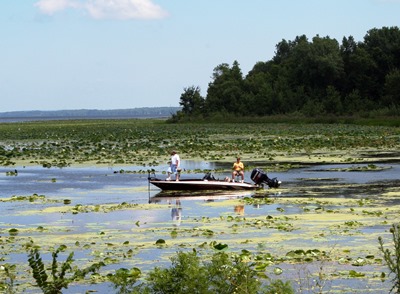
When the League was formed, the stretch of the Mississippi River north of St. Louis was prized by sportsmen for its unique values as fish and wildlife habitat — and prized by developers for the availability of fresh water for use in agriculture and industry.
From 1850 through the early 1900s, the population of states on the Upper Mississippi boomed as Americans moved west. Part of that boom was due to promises of fertile farmland. The Swamp Land Act of 1850 allowed states to acquire areas of “swamp and overflow” lands that the states could reclaim “by means of levees and drains” along much of the Mississippi River floodplain. According to the U.S. Army Corps of Engineers, the plan provided for the transfer of vast amounts of land from the federal government to states, counties, and finally private owners, who could settle the land and use it for agriculture. The Flood Control Act of 1917 marked the beginning of the Corps of Engineers’ involvement in flood control on the Upper Mississippi River — and the start of the federal government’s role in securing the river’s floodplains for agricultural use. Under the Flood Control Acts of 1917 and 1928, the Corps facilitated the drainage of more than 260,000 acres of floodplains.
Some sportsmen immediately saw the damage to fish and wildlife habitat of building levees to separate the Upper Mississippi from its floodplains and draining these areas. When an area critical to bass spawning came under attack, the League fought back.
After hearing that the War Department (which oversaw the Army Corps of Engineers) had approved a drainage plan for an area known as Winneshiek Bottoms — 15,000 acres located along the Wisconsin side of the Mississippi River — a nearby League chapter raised money to file a lawsuit to block the drainage. They also asked the national office for help. Dilg agreed to visit Winneshiek Bottoms if the local chapter could find a farm land expert to accompany him.
The Upper Mississippi River held great personal value for Will Dilg. “I know this Upper Mississippi country from A to Z,” Dilg said. “For twenty odd years, I have averaged at least sixty days on the Upper Mississippi each fishing season, with the single exception of 1922, and then I was angling for game fisher- men instead of game fishes. Nowhere on this earth is there so beautiful a river.” He toured the Bottoms with several League members and a plant physiologist from Iowa State University, who assessed the soil and found the land to be of little value for farming — but of great worth to fish and wildlife and flood protection. That was the scientific evidence Dilg needed to ask Congress to protect the river.
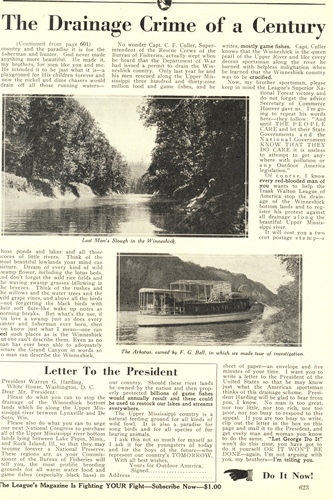
With the Winneshiek Bottoms project tied up in court, Dilg traveled to Washington, D.C., in 1923 with a proposal to create a 300-mile national wildlife refuge on the Upper Mississippi River. To garner national support for the proposal, the July 1923 issue of the League’s magazine heralded “The Drainage Crime of a Century is about to be Committed and You Can Stop It. Will You Do It?” In the article, Dilg described the value of this area and actions needed to save it:
“The Upper Mississippi bottoms are America’s most prolific spawning grounds for black bass and for all warm water game and food fishes.... Nowhere on this earth are there such natural feeding grounds for ducks, brant, and geese. Here also are found every species of our four-footed little animals, such as mink, muskrat, raccoon, skunk, squirrel, swamp rabbit, etc. And last but not least, every kind of song bird by the countless thousands. Veritably, these river lands offer you and your boy and posterity the greatest sport to be found on this planet.
That is true as things are now.... But it’s going to GO — it’s going to be destroyed — these river lands are going to be drained all the way from Lake Pepin, Minn., to Rock Island, Ill. And when these river bottoms are once drained, THEY ARE GONE FOREVER.”
Dilg found a champion in Senator Medill McCormick (IL), who wrote a letter of introduction for Dilg to President Calvin Coolidge. Dilg met with the president for 40 minutes, after which Coolidge was quoted as “favoring any legislation the Izaak Walton League wants.” Dilg worked with members of Congress and government agency staff to draft legislation to establish an Upper Mississippi River refuge. With a last-minute assist from Commerce Secretary Herbert Hoover (a League member) and President Coolidge, the bill passed through Congress and was signed into law less than one year after the League proposed it. The legislation authorized the purchase of up the 345,000 acres of lands and waters on both sides of the river, plus river islands, for the Upper Mississippi River National Wildlife and Fish Refuge.
“VICTORY!” declared Dilg in the July 1924 issue of Outdoor America.
This law was just the first step in establishing the refuge. Congress authorized $1.5 million to acquire land for the refuge, but the law also stated that legislatures in the affected states (Minnesota, Wisconsin, Iowa, and Illinois) had to consent to the land acquisition. League leaders prepared bills for each state legislature to allow the land purchases, and League members successfully advocated at the state level to make the refuge a reality.
Today, the Upper Mississippi River National Wildlife and Fish Refuge includes 240,000 acres of wooded islands, waters, and marshes along more than 260 miles of the river. The refuge is home to more than 270 species of birds, 57 species of mammals, 45 species of amphibians and reptiles, and 113 species of fish. As part of a migratory route for birds, the refuge hosts thousands of tundra swans during the spring and canvasbacks during the fall. More than 3.5 million Americans visit the refuge each year for boating, fishing, hunting, camping, wildlife observation, and other outdoor recreation.
Bringing Back Bass

Perhaps less well-known legislation championed by the League is credited with preventing extinction of America’s bass populations and preserving sport fishing for future generations.
Market hunters in the late 19th century pushed many wildlife species to the brink of extinction. State wildlife laws were not adequate to prevent over hunting and were often difficult to enforce, given that harvested fish and wildlife were often transported to markets in other states. Hunters and anglers pressed the federal government to take action.
In 1900, Congress passed the Lacey Act, which prohibited interstate shipment of wildlife taken in violation of state law. It was a way to add some teeth to state laws and regulate interstate commerce, and it was enough to put most market hunters out of business.
However, the language of the Lacey Act specifically referred to “wild animals and birds,” and states interpreted the law as covering only fur-bearing animals and game birds — leaving America’s fish populations in danger. Overfishing continued unchecked in the early 20th century, particularly for smallmouth and largemouth bass (labeled together as “black bass”). An article in the February 1926 issue of Outdoor America reported, “Scientists state that the yearly toll of black bass in this country is so great compared with the yearly hatch that this greatest of American game fishes is certain to become extinct within 10 years unless extraordinary efforts are made to protect it.”
The League worked with Congressman Harry Hawes (MO) to introduce the Black Bass Act of 1926. The law was the fishing equivalent of the Lacey Act, although it was specific at the time to largemouth and smallmouth bass only. The catch, of course, was ensuring state laws prohibited commercial bass fishing so the federal government had some- thing to enforce. After the Black Bass Act was signed into law in May 1926, League leaders and chapters worked to ensure states had laws prohibiting the sale or shipment of black bass. This effort took years and much coordinated action by League members in affected states.
“So long as there is a legal market anywhere, you may bank on it that thousands of pounds of illegally caught bass will be sold,” declared Seth Gordon, the League’s first Conservation Director, at a Bureau of Fisheries national conference. “The way to stop it is to close all the markets, then give the United States Bureau of Fisheries some funds for the enforcement of the Hawes bass law. The bureau must take a firm stand and help stop the sale of these gamy denizens of our fresh waters.”
The Black Bass Act was amended in 1947 to include all game fish, as defined by state laws; in 1952 to apply to all fish; and in 1969 to apply to fish taken in violation of the law of a foreign country. In 1982, the Black Bass Act was repealed and its provisions incorporated into the Lacey Act. The Lacey Act now protects fish in addition to birds and wildlife — a feat achieved by the Izaak Walton League.
The Herd Mentality
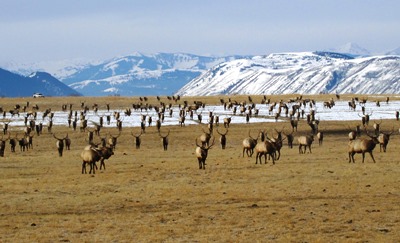
Just a few hundred years ago, 10 million elk roamed North America. By the turn of the 20th century, America’s elk population had dropped to less than 100,000 — about half of those animals residing near Jackson Hole, Wyoming. America’s westward movement had taken a heavy toll on the elk.
Jackson Hole elk spent their summers in the mountains and descended to the lower hills in the fall. When heavy winter snows arrived, many moved to the valley floor, where they foraged for plentiful grass under the layers of snow. The attributes that made Jackson Hole attractive winter shelter for the elk also made it attractive to settlers moving west. As the valley was homesteaded, settlers harvested hay from the valley floor to feed livestock in the winter and let their cattle and sheep graze the hillsides during the warm months — often foraging down to bare dirt. When cold weather hit and the elk moved to the lower hills and valley floor, there was little left
to eat. Each winter, elk carcasses littered the landscape, and by 1920, the herd was down to fewer than 10,000 head.
Residents of Jackson Hole appealed to the federal government for help. In 1912, the federal government created a National Elk Refuge to provide winter habitat and set up a “feeding ranch” in the valley — feeding purchased hay to the elk in the winter. Ranchers themselves fed their extra hay to the elk. By 1916, the Elk Refuge had expanded to 2,760 acres, but the elk population was still declining.
The League invited Hal G. Evarts, outdoor editor of the Saturday Evening Post, to share the elk story with readers of Outdoor America magazine. In “The Final Rally” (December 1924), Evarts described the majestic elk herds and provided stark photos of their demise. He issued a call to action to save the last great elk herd in the United States and asked the League’s sportsmen to take up the call. “The only solution is this: More hay lands must be purchased to supplement those already acquired by the government. Grazing by domestic stock must be checked in the vicinity of the feeding grounds so that natural forage will be available for the thousands of elk that collect there annually. Other areas of winter range must be closed to the grazing of domestic stock. That, and only that, will save our elk.”
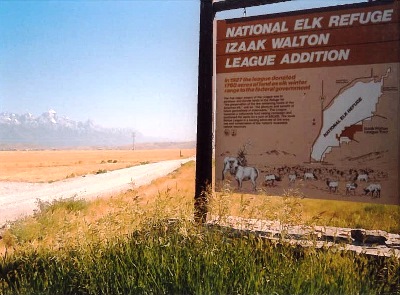
Will Dilg called on sportsmen and all Americans to help the League purchase land for the elk. With that, the League started a national fundraising campaign. The goal was to purchase privately owned meadowland that would connect the first 2,760 acres of the National Elk Refuge with the national forest lands in which the elk spent their summers. By that time, ranchers had determined that the land was not suited to cattle and sheep (too cold for too long) and were eager to sell. After an aggressive fundraising campaign, the League purchased 1,760 acres in Jackson Hole, which it donated to the federal government in 1927.
By the 1930s, the Jackson Hole elk herd had recovered, and numbers continued to increase after the Grand Teton National Park was established, which protected 310,000 acres of summer range just north of the National Elk Refuge. In fact, local elk populations became so robust that these elk were used to re- introduce herds in other states that were part of the elks’ original range — as far east as Pennsylvania.
The League’s donation helped create an area rich in opportunities for wildlife-dependent recreation, from hunting and fishing to wildlife observation and photography. Today, the refuge includes 24,700 acres that provide habitat for elk, bison, wolves, bighorn sheep, and migratory birds and is visited by more than 300,000 people each year. Managing the elk herd size is an important part of refuge managers’ goals, and hunting is part of that strategy. Approximately 200 elk are harvested on the refuge each year (out of 2,000 harvested in the state). In addition, refuge waters are a popular fishing destination and support a wild population of Snake River cutthroat trout — the only trout native to the area. And of course, the elk and other native wildlife are a big draw for wildlife watchers.
Stemming Stream Pollution
Eliminating water pollution was central to the League’s conservation mission from the start. The cause that brought the League founders together was pollution of the Illinois River — a tributary of the Upper Mississippi River. “The opening of the Sanitary Canal in 1900 marked the beginning of a gradual change,” described Charles Schurch in “Restoring a River’s Health,” published in the August 1925 issue of Outdoor America. “First at its source and then advancing slowly downstream, the effect of pollution began to manifest itself. The surface lost its silvery luster and be- came overspread with an oil scum that frequently bore bits of decaying debris. Gasses bubbled up continually from the septic material in its depths and its odor became offensive. The normal life of the river could no longer live there and either perished or retreated downstream.” These conditions stretched 90 miles down the Illinois River and would continue to spread without action to stop the pollution at its source.
The Izaak Walton League petitioned the War Department, which oversaw the Corps of Engineers, to force Chicago’s Sanitary Department to build sewage treatment plants. The Secretary of War agreed. “The construction of these plants is to be started at once and within five years they are to be in operation for the treatment of the sewage of at least 1.2 million of the population,” reported Schurch. “At the end of 10 years, when the diversion of water is to be reduced to the minimum required for navigation alone, these plants will presumably be treating the sewage of the entire city.” One city and one river were saved, but what about the rest of the country?
In December 1926, League national president Charles Folds announced that “the League has started a national campaign to correct the pollution evil in America.” The League established a national Pollution Bureau to work toward restoring the nation’s streams and began that effort in January 1927 by mailing stream surveys to each of the League’s 2,700 chapters. Pollution Bureau staff compared chapter survey information with data available from local, state, and national health and conservation departments to pinpoint problem areas where League staff would conduct further assessments. The results were startling, particularly in heavily populated states.
The League found that more than 7.5 million people in New York were dumping untreated sewage into state waters. In Pennsylvania and Illinois, the numbers were 3 to 4 million each; in Ohio, Indiana, Missouri, and California, 1 to 2 million each. “Taking the United States as a whole, 75 percent of the pollution problem is domestic sewage,” stated Dr. William Hatfield, a water quality and sanitation expert who helped launch the League’s pollution campaign. Although 60 million Americans were served by municipal sewers, the majority of those sewers did not carry the waste to treatment plants. In fact, Hatfield reported, only about one-third of the waste was directed to sewage treatment plants, and half of those plants were poorly designed and operated. Sewage treatment — including educating the public and industry about the issue — became a key part of the League’s national conservation agenda to improve fish and wildlife habitat and drinking water supplies.
League members worked at the state and local levels to identify water quality problems, educate the public, and garner support for change. In July 1928, League national president Dr. Henry Ward reported, “The League has abundant reason to pride itself on the results that have been achieved this year in the great campaign against the pollution menace.” Twenty-nine League chapters had reported their results: Sanitary districts were organized, waste discharges eliminated, lakes cleaned up, and nearly 300 miles of polluted streams restored “to reasonable purity and thus fitted for fish life or for recreational purpose. What a splendid record of achievement!” said Ward. “And yet it represents but a small part of the work actually done, for in many cases larger projects well under way could not be included as the work was not completed.”
While celebrating these successes, Ward also recognized that there was much more work to be done. “It is and must remain the duty of individual chapters to arouse public sentiment and to develop an educated and insistent public spirit, without which the laws are futile and appeals are wasted on empty air.”
A Refuge for Western Waterfowl
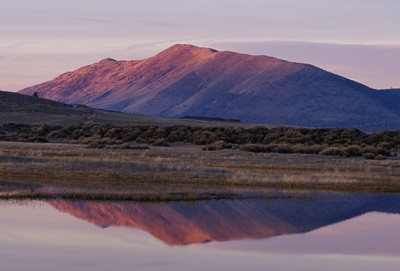
As early as 1916, the U.S. Biological Survey recognized the need to conserve breeding grounds for migratory waterfowl and other birds on lands that were not suited to agricultural use. However, World War I spurred agricultural development across the United States, and by 1924 the U.S. had drained more than 100,000 square miles of wetlands for farmland and hydropower. The threat to wetlands and water re- sources was especially acute in western states.
By the early 1920s, up to 10 million birds had perished in the West from lack of fresh water and adequate feeding grounds, reported D.H. Madsen, Game and Fish Commissioner of Utah. The focal point for this devastation was the Bear River Marshes in Utah, a breeding and nesting area for waterfowl that migrated through the western states of Washington, Oregon, California, Nevada, Idaho, Utah, Arizona, Montana, Wyoming, Colorado, and New Mexico. These wetlands were also critical for shore birds, including the country’s largest populations of herons and snowy egrets.
League Conservation Director Seth Gordon urged members to envision the devastation. “Picture if you can, millions of sick and dying ducks, many of them helpless little fledglings baked to death under the rays of a scorching sun, all for lack of fresh water.
Continuance of the horrible death traps on the remaining 150 square miles of the Bear River Marshes, on Lower Klamath Lake, on Malheur Lake, and other like areas is a crime.”
In 1925, leaders from the Izaak Walton League, National Audubon Society, American Game Protective Association, Western Association of State Game Commissioners, and International Association of State Game, Fish and Conservation Commissioners joined together to draft legislation to save America’s wetlands for migratory waterfowl and other wildlife. To fund land purchases for waterfowl refuges, they suggested redirecting the 10-percent excise tax paid on firearms and ammunition (enacted during World War I). At that time, excise taxes amounted to $3.5 million per year.
However, members of Congress wanted to eliminate the excise tax altogether and were also unwilling to appropriate money from the federal budget for purchasing refuge lands. So supporters of the bill — including the League — were forced to back a $1 federal hunting license to fund the land purchases. (This fee had been proposed a few years earlier in a different refuge bill, which was defeated twice.) League leaders tried to put a positive spin on this development. “This fight has resulted in educating the American people concerning the need for both refuges and public hunting grounds,” said League Conservation Director Seth Gordon. Despite the support of the League and colleague groups, Congress failed to pass the bill.
“The ducks are rapidly going the way of the passenger pigeon,” wrote Gordon in the December 1927 issue of Outdoor America. “Do we want ducks or don’t we? It is now squarely up to the American people.”
Although prospects for passing a refuge bill looked dim, the League did not give up. Numerous compromises came and went during the next session of Congress. Members of the League and partner groups sent more than 200,000 telegrams and letters to Congress in support of the refuge bill. When a compromise bill was finally put to a vote, it passed the House of Representatives unanimously, which gave the bill the momentum it needed to also pass the Senate. When President Coolidge signed the Migratory Bird Conservation Act (also known as the Norbeck-Anderson Act) into law in 1929, the hunting license fee had been eliminated and the refuges were to be funded with $8 million authorized by Congress over 10 years to establish a nationwide system of “inviolate” federal refuges for migratory birds. The law also established the Migratory Bird Conservation Commission to consider and approve land acquisition proposals (a role it still holds today).
The Migratory Bird Conservation Act gave the government authority to acquire land for waterfowl refuges, but it did not provide funding. That problem was solved when League member Jay N. “Ding” Darling came up with the idea of a Federal Duck Stamp, which was authorized by Congress in the Migratory Bird Hunting and Conservation Stamp Act of 1934. Proceeds from the stamps — which must be purchased every year by waterfowl hunters age
16 and older — are deposited into a Migratory Bird Conservation Fund. Since 1934, the U.S. Fish and Wildlife Service has spent more than $1 billion from this fund to protect more than five million acres of waterfowl habitat.
Building Blocks For the Future
Throughout the League’s early year, chapters and state divisions were engaged in a wide range of conservation battles — from wildlife refuges to sewage treatment and river clean-ups. League members were informed and enthusiastic. The organization went through a bit of upheaval during the ouster of its first national president (see sidebar on page 29), but the League’s Board of Directors and staff helped the organization continue moving forward.
In the following decades, the League would be an early leader on topics ranging from environmental impact studies to farmland conservation and the impact of pesticides on land and water quality. Working together, League members, volunteer leaders, and nation- al staff set a course for future conservation successes.